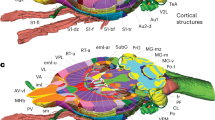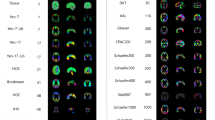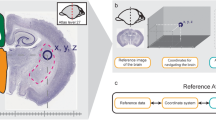Abstract
Brain atlases are widely used in experimental neuroscience as tools for locating and targeting specific brain structures. Delineated structures in a given atlas, however, are often difficult to interpret and to interface with database systems that supply additional information using hierarchically organized vocabularies (ontologies). Here we discuss the concept of volume-to-ontology mapping in the context of macroscopical brain structures. We present Java tools with which we have implemented this concept for retrieval of mapping and connectivity data on the macaque brain from the CoCoMac database in connection with an electronic version of “The Rhesus Monkey Brain in Stereotaxic Coordinates” authored by George Paxinos and colleagues. The software, including our manually drawn monkey brain template, can be downloaded freely under the GNU General Public License. It adds value to the printed atlas and has a wider (neuro-)informatics application since it can read appropriately annotated data from delineated sections of other species and organs, and turn them into 3D registered stacks. The tools provide additional features, including visualization and analysis of connectivity data, volume and centre-of-mass estimates, and graphical manipulation of entire structures, which are potentially useful for a range of research and teaching applications.









Similar content being viewed by others
References
Amunts, K., Schleicher, A., & Zilles, K. (2007). Cytoarchitecture of the cerebral cortex—more than localization. NeuroImage, 37, 1061–1065. doi:10.1016/j.neuroimage.2007.02.037.
Andersen, R. A., Asanuma, C., Essick, G., & Siegel, R. M. (2004). Corticocortical connections of anatomically and physiologically defined subdivisions within the inferior parietal lobule.. The Journal of Comparative Neurology, 296, 65–113. doi:10.1002/cne.902960106.
Bezgin, G., Wanke, E., Krumnack, A., & Kötter, R. (2008). Deducing logical relationships between spatially registered cortical parcellations under conditions of uncertainty. Neural Networks. doi:10.1016/j.neunet.2008.05.010
Black, K. J., Koller, J. M., Snyder, A. Z., & Perlmutter, J. S. (2004). Atlas template images for nonhuman primate neuroimaging: Baboon and macaque. In P. M. Conn (Ed.), Imaging. Methods in enzymology 385 (pp. 91–102). New York: Elsevier.
Bowden, D. M., & Martin, R. F. (1995). NeuroNames brain hierarchy. NeuroImage, 2, 63–83. doi:10.1006/nimg.1995.1009.
Brodmann, K. (1905). Beiträge zur histologischen Lokalisation der Groβhirnrinde. III. Mitteilung. Die Rindenfelder der niederen Affen. Journal of Psychology and Neurology, 4, 177–226.
Brodmann, K. (1909). Beitrage zur histologischen Localisation der Grosshirnrinde. Dritte Mitteilung. Die Rindenfelder der niederen Affen. Journal für Psychologie und Neurologie, 4, 177–226.
Clower, D. M., West, R. A., Lynch, J. C., & Strick, P. L. (2001). The inferior parietal lobule is the target of output from the superior colliculus, hippocampus, and cerebellum. The Journal of Neuroscience, 21, 6283–6291.
Crook, S., Beeman, D., Gleeson, P., & Howell, F. (2005). XML for model specification in neuroscience. Brain Minds Media, 1, 1–24.
Dijkstra, E. W. (1959). A note on two problems in connexion with graphs. Numerische Mathematik, 1, 269–271. doi:10.1007/BF01386390.
Ding, S.-L., van Hoesen, G., & Rockland, K. (2000). Inferior parietal lobule projections to the presubiculum and neighboring ventromedial temporal cortical areas. The Journal of Comparative Neurology, 425, 510–530. doi:10.1002/1096-9861(20001002)425:4<510::AID-CNE4>3.0.CO;2-R.
Gering, D. T., Nabavi, A., Kikinis, R., Hata, N., O’Donnell, L. J., Grimson, W. E. L., et al. (2001). An integrated visualization system for surgical planning and guidance using image fusion and an open MR. Journal of Magnetic Resonance Imaging, 13, 967–975. doi:10.1002/jmri.1139.
Goddard, N. H., Hucka, M., Howell, F., Cornelis, H., Shankar, K., & Beeman, D. (2001). Towards NeuroML: model description methods for collaborative modeling in neuroscience. Philosophical Transactions of the Royal Society of London. Series B, Biological Sciences, 356, 1209–1228. doi:10.1098/rstb.2001.0910.
Golbreich, C., Bierlaire, O., Dameron, O., & Gibaud, B. (2005). Use case: Ontology with rules for identifying brain anatomical structures. In: W3C Workshop on Rule Languages for Interoperability.
Hjornevik, T., Leergaard, T. B., Darine, D., Moldestad, O., Dale, A. M., Willoch, F., et al. (2007). Three-dimensional atlas system for mouse and rat brain imaging data. Frontiers in Neuroinformatics, 1, 1–11. doi:10.3389/neuro.11.004.2007.
Howell, F., McDonnell, N., Zaborszky, L., & Varsanyi, P. (2005). Tools for integrating 3D single cell and population neuroanatomy data. In: UK e-science All Hands Meeting 2005 Nottingham UK.
Kötter, R. (2004). Online retrieval, processing, and visualization of primate connectivity data from the CoCoMac database. Neuroinformatics, 2, 127–144. doi:10.1385/NI:2:2:127.
Kötter, R. (2007). Anatomical concepts of brain connectivity. In V. Jirsa, & A. R. McIntosh (Eds.), Handbook of brain connectivity, series: Understanding complex systems (pp. 149–166). Berlin: Springer.
Kötter, R., & Wanke, E. (2005). Mapping brains without coordinates. Philosophical Transactions of the Royal Society of London. Series B, Biological Sciences, 360, 751–766. doi:10.1098/rstb.2005.1625.
Lewis, J. W., & Van Essen, D. C. (2000a). Corticocortical connections of visual, sensorimotor, and multimodal processing areas in the parietal lobe of the macaque monkey. The Journal of Comparative Neurology, 428, 112–137. doi:10.1002/1096-9861(20001204)428:1<112::AID-CNE8>3.0.CO;2-9.
Lewis, J. W., & Van Essen, D. C. (2000b). Mapping of architectonic subdivisions in the macaque monkey, with emphasis on parieto-occipital cortex. The Journal of Comparative Neurology, 428, 79–111. doi:10.1002/1096-9861(20001204)428:1<79::AID-CNE7>3.0.CO;2-Q.
Martin, R. F., & Bowden, D. M. (1996). A stereotaxic template atlas of the macaque brain for digital imaging and quantitative neuroanatomy. NeuroImage, 4, 119–150. doi:10.1006/nimg.1996.0036.
Mechouche, A., Golbreich, C., & Gibaud, B. (2006). Semantic description of brain MRI images. In: First International Workshop on Semantic Web Annotations for Multimedia.
Morel, A., Liu, J., Wannier, T., Jeanmonod, D., & Rouiller, E. M. (2005). Divergence and convergence of thalamocortical projections to premotor and supplementary motor cortex: a multiple tracing study in the macaque monkey. The European Journal of Neuroscience, 21, 1007–1029. doi:10.1111/j.1460-9568.2005.03921.x.
Mussen, A. T. (1967). A cyto-architectural atlas of the brain stem of Macacus rhesus. In A. T. Mussen (Ed.), The cerebellum and red nucleus. Anatomy and physiology. New York: Hafner.
Paxinos, G., & Watson, C. (1998). The rat brain in stereotaxic coordinates (4th ed.). San Diego: Academic.
Paxinos, G., Huang, X.-F., & Toga, A. W. (2000). The rhesus monkey brain in stereotaxic coordinates. New York: Academic.
Rizzolatti, G., Luppino, G., & Matelli, M. (1998). The organization of the cortical motor system: new concepts. Electroencephalography and Clinical Neurophysiology, 106, 283–296. doi:10.1016/S0013-4694(98)00022-4.
Saleem, K. S., & Logothetis, N. K. (2006). A combined MRI and histology atlas of the rhesus monkey brain. London: Elsevier.
Seltzer, B., & Pandya, D. N. (1978). Afferent cortical connections and architectonics of the superior temporal sulcus and surrounding cortex in the rhesus monkey. Brain Research, 149, 1–24. doi:10.1016/0006-8993(78)90584-X.
Smith, O. A., Kastella, K. G., & Randall, D. C. (1972). A stereotaxic atlas of the brain stem of Macaca mulatta in the sitting position. The Journal of Comparative Neurology, 145, 1–23. doi:10.1002/cne.901450102.
Sporns, O., Tononi, G., & Kötter, R. (2005). The human connectome: a structural description of the human brain. PLoS Computational Biology, 4, 245–251.
Stephan, K. E., Kamper, L., Bozkurt, A., Burns, G. A. P. C., Young, M. P., & Kötter, R. (2001). Advanced database methodology for the collation of connectivity data on macaque brain (CoCoMac). Philosophical Transactions of the Royal Society of London. Series B, Biological Sciences, 356, 1159–1186. doi:10.1098/rstb.2001.0908.
Szabo, J., & Cowan, W. M. (1984). A stereotaxic atlas of the brain of the Cynomolgus monkey (Macaca fascicularis). The Journal of Comparative Neurology, 222, 265–300. doi:10.1002/cne.902220208.
Takada, M., Nambu, A., Hatanaka, N., Tachibana, Y., Miyachi, S., Taira, M., et al. (2004). Organization of prefrontal outflow toward frontal motor-related areas in macaque monkeys. The European Journal of Neuroscience, 19, 3328–3342. doi:10.1111/j.0953-816X.2004.03425.x.
Talairach, J., & Tournoux, P. (1988). Co-planar stereotaxic atlas of the human brain: 3-dimensional proportional system—an approach to cerebral imaging. New York: Thieme.
Toga, A. W., & Thompson, P. M. (2001). Maps of the brain. The Anatomical Record, 265, 37–53, The New Anatomist. doi:10.1002/ar.1057.
Tuch, D. S., Wisco, J. J., Khachaturian, M. H., Ekstrom, L. B., Kötter, R., & Vanduffel, W. (2005). Q-ball imaging of macaque white matter architecture. Philosophical Transactions of the Royal Society of London. Series B, Biological Sciences, 360, 869–879. doi:10.1098/rstb.2005.1651.
Tzourio-Mazoyer, N., Landeau, B., Papathanassiou, D., Crivello, F., Etard, O., Delcroix, N., et al. (2002). Automated anatomical labeling of activations in SPM using a macroscopic anatomical parcellation of the MNI MRI single-subject brain. NeuroImage, 15, 273–289. doi:10.1006/nimg.2001.0978.
Van Essen, D. C., & Dierker, D. L. (2007). Surface-based and probabilistic atlases of primate cerebral cortex. Neuron, 56, 209–225. doi:10.1016/j.neuron.2007.10.015.
Van Essen, D. C., Harwell, J., Hanlon, D., & Dickson, J. (2005). Surface-based atlases and a database of cortical structure and function. In S. H. Koslow, & S. Subramaniam (Eds.), Databasing the brain: from data to knowledge (Neuroinformatics), ch. 22. New York: Wiley.
Vogt, C., & Vogt, O. (1919). Ergebnisse unserer Hirnforschung. 1.-4. Mitteilung. Journal of Psychology and Neurology, 25, 279–461.
Worsley, K. J., Charil, A., Lerch, J., & Evans, A. C. (2005). Connectivity of anatomical and functional MRI data. Neural Networks, 3, 1534–1541.
Zhong, Y., & Rockland, K. S. (2003). Inferior parietal lobule projections to anterior inferotemporal cortex (area TE) in macaque monkey. Cerebral Cortex (New York, N.Y.), 13, 527–540. doi:10.1093/cercor/13.5.527.
Acknowledgements
The authors were funded by the McDonnell Foundation, and also acknowledge the DFG (KO 1560/6-2, WA 674/10-2). We are very grateful for the contributions of the following colleagues: Andrew Janke, Hartmut Mohlberg: advice and feasibility studies concerning concept and implementation; Nicola McDonnell, Fred Howell, Robert Cannon, Laszlo Zaborszky, Peter Varsanyi: Virtual Brain software; Christoph Edel: manual drawing of brain structures; M. Mallar Chakravarty, Stephen Frey, D. Louis Collins: improved alignment of sections; Deepak N. Pandya, Klaas E. Stephan: relations between partitioning schemes; George Paxinos, Xu-Feng Huang, Michael Petrides, Arthur W. Toga: critique and encouragement; Ingo Bojak and Rembrandt Bakker: helpful discussions.
Author information
Authors and Affiliations
Corresponding author
Appendix
Appendix
Abbreviations used in this paper
- 10:
-
area 10 of cortex
- 10D:
-
area 10 of cortex, dorsal part
- 10M:
-
area 10 of cortex, medial part
- 10V:
-
area 10 of cortex, ventral part
- 23:
-
area 23 of cortex (posterior cingulate cortex)
- 8A:
-
area 8A (frontal eye field)
- PG:
-
parietal area PG (caudal inferior parietal lobule)
- PGa:
-
area PG associated region in the superior temporal sulcus
- TPO:
-
temporal parietooccipital associated area in the superior temporal sulcus
- V1:
-
area V1 (primary visual cortex)
- V2:
-
area V2 (secondary visual cortex)
- V3A:
-
visual area V3A
- V4:
-
visual area 4
- V4D:
-
visual area 4, dorsal part
- V4V:
-
visual area 4, ventral part
- X:
-
an existing connection with unknown density ranking
Code organization
Aiming to describe each of the software modules presented in the Software architecture section in more detail, we will start from the ones having been developed formerly for representing the rat brain structures.
Java3d Handler module introduces widgets for the rendering of three-dimensional structures, in addition to those presented in Java3d API itself. It consists of the following classes:
-
Java3DBehavior.java handles various structure manipulation options, such as rotating, scaling, shifting, and mouse behaviour.
-
Java3DColours.java consists of static methods representing various colors options; all those methods return objects of type Color3f except for one, which generates a Material instance (see Java3D API javadoc, http://java.sun.com/products/java-media/3D/forDevelopers/J3D_1_2_API/j3dapi/javax/media/j3d/Material.html)
-
Java3DDebug.java—debugger widgets.
-
Java3DHandler.java, the main module class which implements basic rendering, parameter setting, and event handling.
-
Java3DModel.java is a supplementary class for the previous one, providing additional necessary capabilities and setting default options.
-
Java3DPanel.java integrates the features into the graphical user interface (GUI).
-
Java3DPopupMenu.java does the obvious.
-
Java3DSurface.java presents several options for surface rendering.
-
Java3DToolbar.java is a supplementary class for Java3DPanel.java.
The MorphML handler package contains classes necessary for rendering particular brain structures. It also contains parsers for Neurolucida (http://www.mbfbioscience.com/neurolucida/) and Accustage (http://www.accustage.com/) file formats, not used by our tools, which do not deal with microscopic structures and therefore for practical reasons exploit SVGs for graphical representations instead. Therefore, we would make an outlook at those classes being used for our particular tool. Here are the descriptions of these classes:
-
Feature.java and ComplexFeature.java. They introduce the entities representing the brain structures. The former class displays entities as they are depicted in the original atlas, whereas the latter one describes those brain structures consisting of sub-features, according to the CoCoMac nomenclature.
-
MorphMLHandler.java class instances are called by reference when the features have to be loaded into the atlas. The class implements the creation of new entities, which represent brain structures.
-
MorphMLJava3DPanel.java extends Java3DPanel.java class (see description above), adapting it to deal with concrete brain structures. In addition to capabilities for rendering geometrical primitives (e.g., cubes, spheres, cylinders), provided in the parent class, here those for rendering specific brain features are presented.
-
MorphMLRenderer.java introduces various options for brain structures rendering—representing them as a wireframe mesh, or as solid structures of particular thickness. For our tool, we used only the latter representation.
-
MorphMLTree.java organizes the structures list hierarchically. In the Fig. 9, it is shown as a separate module (Structures tree) for clarity.
-
MorphMLUtil.java provides additional rendering widgets, and necessary geometrical algorithms.
-
Morphology.java class represents the entity containing all Feature.java and ComplexFeature.java instances, and methods for rendering the entire set of brain structures loaded into the electronic atlas.
The remaining modules were created specifically for the present tool.
The file parsers shown as SVG parser and Structure names file handler modules contain two following classes:
-
SVGHandler.java. This class provides an appropriate handling for instructions given in SVG scripts for displaying the atlas graphics files. Among other instructions, there are also cubic Bezier curves present, to allow a smoother polygon representation. The following parametric form represents the mathematical basis of this instruction:
$$B\left( t \right) = \left( {1 - t} \right)^3 P_0 + 3t\left( {1 - t} \right)^2 P_1 + 3t^2 \left( {1 - t} \right)P_2 + t^3 P_3 ,\,\,t \in \left[ {0,1} \right]$$(4)
using starting point P 0, end point P 3 and two control points, P 1 and P 2.
-
PaxinosHandler.java. This class uses JXL API (http://docjar.com/docs/api/jxl/) developed for working with Excel files in Java. It reads the data file containing area names, acronyms, RGB patterns and descriptions of hierarchical organization for complex features.
-
CoCoMac query module is represented by the classes CoCoMacHandler.java and CoCoMacQueryMaker.java. The former class enables the display of information related to connectivity, mapping, literature and brain sites in a system default internet browser, whereas the latter class connects to the database directly via a JDBC-ODBC interface bridge, and handles appropriate SQL statements necessary for displaying connectivity data graphically.
The rest of the modules are parts of uk.ac.ed.paxinos3d package, which contains appropriate widgets necessary exclusively for the current project. Here are the descriptions of the classes included:
-
DataVisualisation.java and Query.java handle the graphical display of connectivity data specific for the current atlas.
-
View.java creates a GUI specific for the current project. It integrates the features introduced by two classes in MorphML handler API, namely MorphMLJava3DPanel.java and MorphMLTree.java, providing a native look and feel.
-
Model.java handles all the events occurring in the above class.
-
Controller.java class initializes all the event handlers for the previous class.
The last three classes are integrated by the class Main.java which launches the software.
Finally, there are some supplementary classes—e.g., the one allowing to display a URL in a browser, regardless of the operating system used (Previewer.java), and a class providing native look and feel (WindowUtilities.java); constants related to this particular atlas (Paxinos et al. 2000) are handled in a separate class Constants.java.
Rights and permissions
About this article
Cite this article
Bezgin, G., Reid, A.T., Schubert, D. et al. Matching Spatial with Ontological Brain Regions using Java Tools for Visualization, Database Access, and Integrated Data Analysis. Neuroinform 7, 7–22 (2009). https://doi.org/10.1007/s12021-008-9039-5
Received:
Accepted:
Published:
Issue Date:
DOI: https://doi.org/10.1007/s12021-008-9039-5




